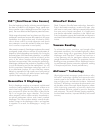
Placement & Room Acoustics 9
Tilting the Speakers Backwards and Forwards
As the diagrams show in the Dispersion Interactions sec-
tion of this manual (page 12), the vertical dispersion is
directional above and below the stator panel itself. In
some instances, if you are sitting close to the floor, slight
forward tilting of the speakers can enhance clarity and
precision. Tilt can be adjusted by adjusting the MiniETC
spikes (see page 11).
Your Purity loudspeaker also is equipped with a pivoting
base which allows the speaker to achieve an additional
12° of tilt beyond the standard 1°. Experimenting with
increased tilt may yield a superior listening experience.
1 Turn off you amplifier. Unplug the speakers and discon-
nect all wires from the back of the Purity.
2 Using a blanket to protect Purity’s cabinet, place the
speaker on its side.
3 Loosen and remove the hand nut on bottom of the
speaker.
4 Remove the base, rotate it, and replace it.
5 Re-attach the hand nut.
Imaging
In their final location, your Purity’s can have a stage
width somewhat wider than the speakers themselves.
On well recorded music, the instruments can extend
beyond the edges of each speaker (left and right), yet
a vocalist should appear directly in the middle. The size of the
instruments should be neither too large nor too small, subject
to the intent and results of each unique audio recording.
Additionally, you should find good clues as to stage
depth. Make sure that the vertical alignment, distance from
the front wall, and toe-in is exactly the same for both speakers.
This will greatly enhance the quality of your imaging.
Bass Response
Your bass response should neither be one note nor
should it be too heavy. It should extend to the deep-
est organ passages and yet be tight and well defined.
Kick-drums should be tight and percussive—string
bass notes should be uniform and consistent through-
out the entirety of the run without booming or thudding.
Tonal Balance
Voices should be natural and full and cymbals
should be detailed and articulate yet not bright and
piercing, pianos should have a nice transient characteristic
and deep tonal registers. This will give you clues on how to
get closer to these ideal virtues.
Final Placement
After the full break in period, obtaining good wall treat-
ments, and the proper toe-in angle, begin to experiment
with the distance from the wall behind the speakers. Move


















